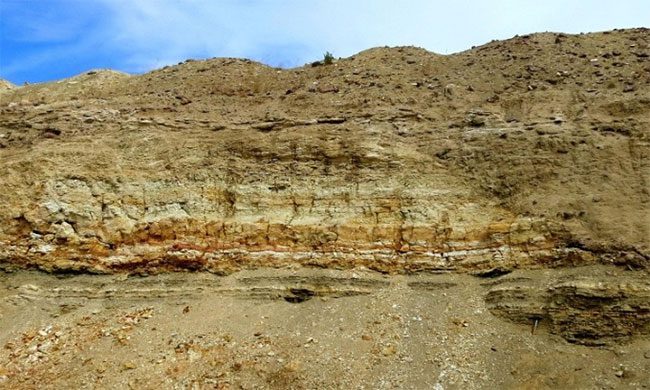The McDermitt Caldera, a volcanic crater located on the Nevada-Oregon border, contains an estimated 20 to 40 million tons of lithium, capable of meeting the soaring global demand.
Estimated at 20 to 40 million tons of lithium, this resource is situated within a volcanic crater formed 16 million years ago. This reserve is significantly larger than the lithium mine located beneath a salt flat in Bolivia, which was previously considered the largest lithium mine in the world, Futurism reported on September 10th. According to geologist Anouk Borst from KU Leuven University and the Royal Museum for Central Africa in Tervuren, Belgium, this mineral deposit could change the global distribution of lithium in terms of pricing, supply security, and geopolitics.

Lithium-rich shale layers in McDermitt Caldera. (Photo: Chris Henry)
On-site analysis reveals an unusual shale layer composed of illite minerals, containing 1.3 to 2.4% lithium within the volcanic crater. This ratio is nearly double the amount of lithium found in the more common magnesium smectite clay mineral. Several conditions contributed to the formation of this new lithium deposit. The crater known as McDermitt Caldera appeared 16.4 million years ago when 1,000 km3 of magma erupted. The caldera filled with eruptive materials from sodium, potassium, lithium, chlorine, and boron-rich magma. These materials cooled rapidly, forming volcanic rock with fine crystals that weathered, leading to the accumulation of lithium-rich particles.
Later, a lake formed within the crater, persisting for hundreds of thousands of years. Eroded volcanic material around the area contributed to the creation of clay sediments at the lake’s bottom. Researchers’ analyses revealed that after the lake dried up, another eruption caused the sediments to come into contact with hot alkaline water rich in lithium and potassium.
Thomas Benson, a geologist at Lithium Americas Corporation, and his team believe that the hot alkaline water created a layer of illite about 40 meters thick in the lake sediments. The fluid rose through cracks that formed when the volcano became active again, transforming smectite into illite in the southern area of the crater known as Thacker Pass. As a result, the shale layer contains a high percentage of lithium.
According to Benson, his company plans to begin lithium extraction in 2026. They will separate the clay from the water, then extract lithium-rich particles from larger minerals using centrifugation. Next, the clay will be soaked in a sulfuric acid bath to filter out lithium. Benson assesses that the lithium-rich shale at Thacker Pass is among the most unique of volcanic sedimentary strata. The exploration of lithium deposits following eruptions should focus on calderas with hydrothermally altered lake sediments.
Data from the United States Geological Survey (USGS) indicates that the countries with the largest lithium reserves include Bolivia, Argentina, the United States, Chile, Australia, and China. Among these, Australia and Chile are the two largest lithium producers, accounting for nearly 77% of global production in 2022, with 61,000 tons (46.9%) and 39,000 tons (30%) respectively, while China produced 19,000 tons, representing 14.6%.


















































